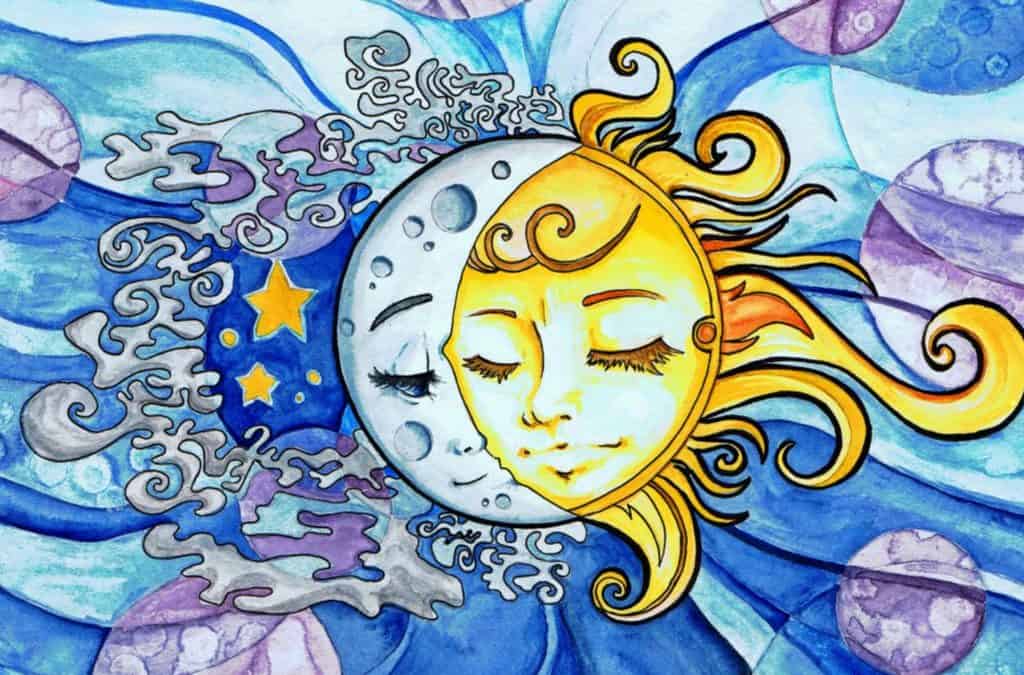Current archaeological and anthropological research suggests that throughout Europe, as well as in the area known as the Fertile Crescent – encompassing modern-day Syria, Palestine, Israel, Iraq, and the Nile Valley – during the Neolithic period, a set of closely related religious beliefs was widely held.
Gender Roles in Ancient Astrology
The Sun and the Moon — Symbols of Masculinity and Femininity
Predominantly, the religious framework of the Neolithic or Bronze Age was centered around the worship of maternity or fertility as the most significant and apparent mystery of nature. It was also considered the closest mystery or marvel to everyday life and the most fundamental needs of society.
Nearly all anthropomorphic figurines discovered from this era represent female deities, some visibly pregnant. This underscores that the earliest concepts of divinity were associated with women or femininity, suggesting that Goddesses likely predated Gods.
During this era, spanning from 4000 to 1500 BCE, the concept of fatherhood had not yet been embraced. Maternity was viewed as independent and autonomous.
Thus, Gods were merely subordinate elements to the Great Goddess, who ruled omnipotently and immortally over the fates of all beings. Being independent in her creative and governing roles, the Great Goddess did not need the institution of marriage.
The Power of Women
Matriarchy: A Testament to Female Independence and Power
In these societies, women were chiefly responsible for most religious and political functions. Men were expected to obey and worship the Great Goddess and her earthly embodiment, the High Priestess, resulting in a social structure with a feminine apex.
Given the limited understanding of sexual function concerning procreation, sex was seen more as a pleasurable and religious activity. The practice of sacred sexuality (sometimes akin to sacred prostitution) was common.
Orgiastic ceremonies, sexual freedom, and the near-total independence of women from men were prevalent.
In some instances, roles were reversed, with women dominating men, as seen in the case of the Libyan Amazons and other communities south of the Black Sea.
Feminine Emblems
Initially, both the Sun and the Moon were perceived as feminine emblems.
They symbolized the power of the Great Goddess. It wasn’t until much later that the Sun came to be associated with patriarchal power, leaving the Moon exclusively linked to women.
The Moon has always been connected with femininity due to its phases’ resemblance to the menstrual cycle. Its three phases were also linked to the three stages of a woman’s life:
- The Maiden = Waxing Moon;
- The Nymph (woman of childbearing age) = Full Moon;
- The Crone = Waning Moon.
These phases were also correlated with the solar calendar in matriarchal societies, which recognized three seasons:
- The Maiden with Spring;
- The Nymph with Summer;
- The Crone with Winter.
A more modern interpretation is the female triad: Selene-Aphrodite-Hecate, symbolizing the Maiden = Selene (the aerial world) – the Nymph = Aphrodite (the terrestrial world) – the Crone = Hecate (the underworld).
These three personifications of the Great Goddess were essentially three stages of the same entity. This primitive Holy Trinity was worshipped in any form, with the understanding that they were one being. In some temples, she was venerated under a single name: Goddess Hera.
Matriarchal Societies
These early matriarchal societies were governed by Queens. Inheritance of the title was through the female line, with the youngest, not the eldest as in patriarchal societies, inheriting the throne.
Men who became Kings did so by marriage to the heiress, as depicted in ancient myths where heroes are rewarded with the hand of the king’s youngest daughter – the heir – for their feats.
Until the status of men in society improved, which seems not to have happened before the second millennium, the King had a religious role. Tribes would annually select a King for their Nymph-Queen from the young men of the realms.
This King held little executive power, as authority typically resided with the Queen or her immediate family: brothers, maternal uncles, etc.
The annual Sacred King’s role was to accompany the Queen to social ceremonies and participate in governance with limited and delegated powers from the Queen.
At the year’s end, the King was ritually sacrificed (enduring various tortures and mutilations, often under the influence of drugs), with his body buried or cremated according to the customs of each society.
Sometimes, the King’s body was ritually dismembered and consumed by the Queen’s nymph companions, and his blood was scattered across the fields to ensure their fertility.
In some societies, two Sacred Kings were chosen, with the second replacing the first in the second half of the year, following a pre-established ritual killing……
The Egyptian Tarot and the Sacred King
In the Egyptian Tarot, where the fate of the Sacred King is depicted, the first thirteen cards represent the thirteen months of the ancient year. The thirteenth month signifies the sacrifice of the Sacred King, symbolized by the Death card.
The demise of the Sacred King, the origin of the ominous connotation of the number 13, follows the twelfth card in the Tarot, which represents the sacrifice ceremony of the Sacred King.
As the life of the King was analogously linked to the seasonal life of the Sun, the Sun became a symbol of masculine fertility, especially once the necessary role of men in procreation was officially recognized.
Nevertheless, the Moon held greater significance than the Sun in earlier societies. All religious ceremonies and significant dates were calculated according to lunar phases. Solstices and equinoxes were only approximately known, thus taking a backseat in importance to lunar phases…
Astrology and Kabbalah, united in a personalized system for you
Connect with your Personal Kabbalistic Tree, designed based on your birth and name. This system will help you work on your emotions, improve your health, and move closer to your spiritual purpose.
Take control of your well-being with an approach that blends ancient wisdom and personalization.





